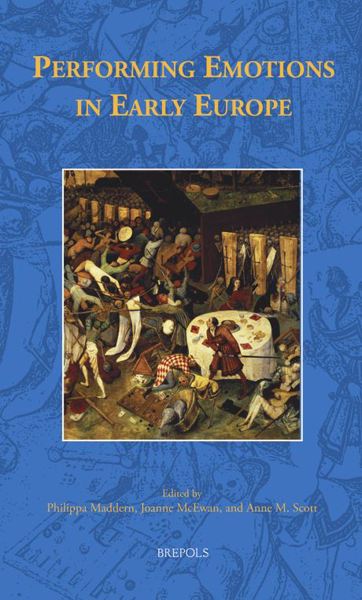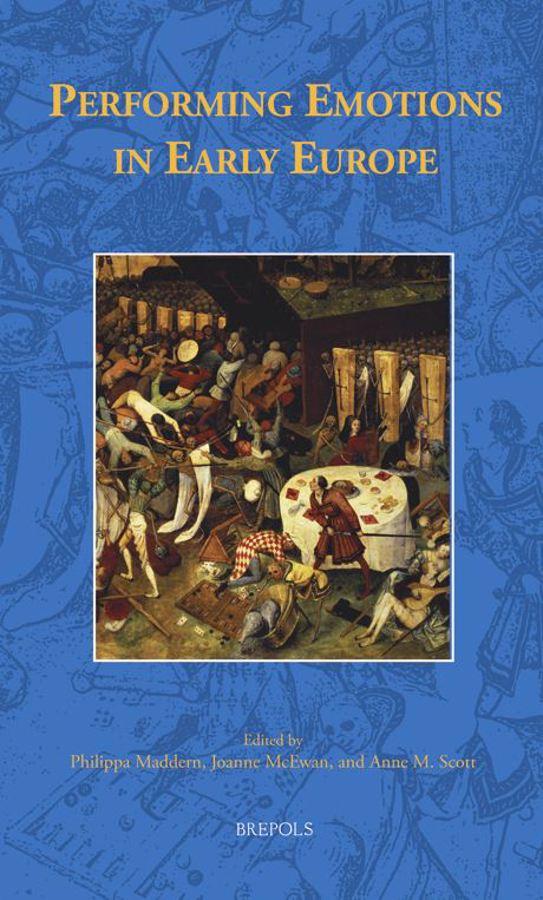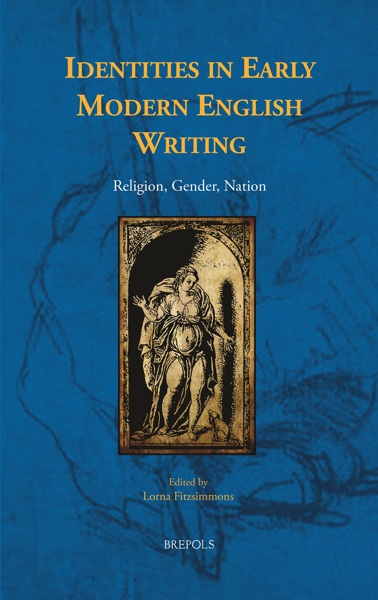
Performing Emotions in Early Europe
Philippa Maddern †, Joanne McEwan, Anne M. Scott (eds)
- Pages: xxx + 296 p.
- Size:156 x 234 mm
- Illustrations:25 b/w
- Language(s):English
- Publication Year:2018
- € 95,00 EXCL. VAT RETAIL PRICE
- ISBN: 978-2-503-57237-6
- Hardback
- Available
- € 95,00 EXCL. VAT RETAIL PRICE
- ISBN: 978-2-503-57296-3
- E-book
- Available
New perspectives on the performance of pre-modern emotions from international experts.
"Overall, the volume achieves a breadth of coverage and depth of analysis that will make it an indispensable source for historians of emotion in Europe’s medieval and early modern periods." (Bruce Buchan, in Emotions: History, Culture, Society, 2/2, 2018, p. 351)
« (…) ce livre est le résultat d’un travail créatif marqué par l’ouverture disciplinaire et par la volonté d’expérimenter de nouvelles voies pour approcher les sources historiques. Ce volume est ainsi tout à fait représentatif du travail effectué au CHE ces dernières années et suscitera une bonne dose de stimulation intellectuelle chez le lecteur.» (Xavier Biron-Ouellet, dans Francia-Recensio, 1, 2019)
“It is simply a must-read for any scholar interested in the study of emotions or religious and social experiences in early European history.” (Daniel H. Fogt, in The Sixteenth Century Journal, LIII/1, 2022, p. 223)
Drawing on a range of interdisciplinary approaches and innovative methodologies, this collection contributes ground-breaking new scholarship in the burgeoning field of emotions studies by examining how medieval and early modern Europeans communicated and ‘performed’ their emotions. Rejecting the notion that emotions are ‘essential’ or ‘natural’, this volume seeks to pay particular attention to cultural understandings of emotion by examining how they were expressed and conveyed in a wide range of historical situations. The contributors investigate the performance and reception of pre-modern emotions in a variety of contexts — in literature, art, and music, as well as through various social and religious performances — and in a variety of time periods ranging from the twelfth to the eighteenth centuries. These studies provide both case-studies of particular emotions and emotional negotiations, and examinations of how their categorisation, interpretation, and meaning has changed over time.
The contributors provide new insights into the expression and performance of pre-modern emotions from a wide range of disciplinary fields, including historical studies, literature, art history, musicology, gender studies, religious studies, and philosophy. Collectively, they theorise the performativity of medieval and early modern emotions and outline a new approach that takes fuller account of the historical specificity and cultural meanings of emotions at particular points in time.
This volume forms a companion to Understanding Emotions in Early Europe, edited by Michael Champion and Andrew Lynch (2015); http://www.brepols.net/Pages/ShowProduct.aspx?prod_id=IS-9782503552644-1
Introduction: Performing Emotions in Medieval and Early Modern Worlds — PHILIPPA MADDERN, JOANNE MCEWAN and ANNE M. SCOTT
Part I: Emotional Performativity in Music, Literature and the Visual Arts
Emotion, Time and Music at Cambrai Cathedral — MATTHEW CHAMPION
‘Affecting glory from vices’: Negotiating Shame in Prostitution Texts, 1660–1750 — EMILY COCK
Pageant, Spectacle, Dread and Love in Piers Plowman, Brueghel’s Triumph of Death and the Good Samaritan Window of Bourges Cathedral — ANNE M. SCOTT
Affected Bodies and Bodily Affect: Visualizing Emotion in Renaissance Plague Images — LOUISE MARSHALL
Part II: Social Performance
The ‘Slime of Vice’ and the ‘Passions of the Mind’: Emotional Histories in the Anglo-Norman World — LINDSAY DIGGELMANN
Courting Nassau Affections: Performing Love in Orange-Nassau Marriage Negotiations — SUSAN BROOMHALL and JACQUELINE VAN GENT
‘[D]id ringe at oure parish churche... for joye that the Queene of Skotts ... was beheaded’: Public Performances of Early Modern English Emotions — DOLLY MACKINNON
Part III: Religious Performance
Emotion, Place and Memory at the Royal Abbey of St Denis — MEGAN CASSIDY-WELCH
Boosting the Emotional Power of New Liturgy: The Hidden Sides of Things in Giotto’s Crib at Greccio — RICHARD READ
Discursive Affect and Emotional Prescriptiveness: On the ‘Man of Sorrows’ in Fourteenth-Century Italian Painting — LACHLAN TURNBULL
Martin Luther’s Heart — SUSAN C. KARANT-NUNN
Part IV: Recreating Emotional Performance
‘Laughing at Death’: Emotional Excess in The Duchess of Malfi in Performance — STEVE CHINNA
Index




